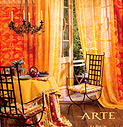| |
1
/ How to Get Started 2 / Focus on Components of Form 3 / Exercise Your Creativity |
 What
is the best way to start an interior design project? From
buying new furniture, to painting a room, to moving into a new
home, or to building your dream home--how do you REALLY start
the design process? What are the "rules"?
What
is the best way to start an interior design project? From
buying new furniture, to painting a room, to moving into a new
home, or to building your dream home--how do you REALLY start
the design process? What are the "rules"?
This question bewilders and frightens many people, including the professional designers. Making decisions that involve aesthetic, practical and budgetary aspects all at once is often stifling. Our design choices stay with us for many years and are a component of the investment in our homes. So, having confidence and a plan to ensure a successful project is paramount.
Expand
your style options and
imprint good taste throughout your home!
 If you look at 100 magazines, books, textbooks, newspapers,
and web sites, you will find 10,000 different opinions on the design process
-- where it begins, how to work it and how to develop comfortable, tasteful
interiors. There is consensus about neither the design process nor on
how to apply this discipline to achieve successful results. The reason
is simple --interior decorating is an art form, not a scientific
approach to an experiment. As an art form, the design process is often
subjective and creative, not dogmatic. However, design professionals,
academics, and aficionados agree that good interior design is a harmonious
combination of design elements and principles that reflect a personal
style, comfort and budget.
If you look at 100 magazines, books, textbooks, newspapers,
and web sites, you will find 10,000 different opinions on the design process
-- where it begins, how to work it and how to develop comfortable, tasteful
interiors. There is consensus about neither the design process nor on
how to apply this discipline to achieve successful results. The reason
is simple --interior decorating is an art form, not a scientific
approach to an experiment. As an art form, the design process is often
subjective and creative, not dogmatic. However, design professionals,
academics, and aficionados agree that good interior design is a harmonious
combination of design elements and principles that reflect a personal
style, comfort and budget.
"Any hope for a set of rules that will guarantee design excellence must be put aside." (John F. Pile)
So how do you do all of this and achieve a benchmark result?
Focus on Personal Style
 A well-designed interior should be "an
expression of your particular tastes and experiences."
Above all, "you should arrive at a style all your own".
(Tricia Guild)
A well-designed interior should be "an
expression of your particular tastes and experiences."
Above all, "you should arrive at a style all your own".
(Tricia Guild)
To understand personal style and make sense of applying this to your living spaces, you must get in touch with what you favor and focus on what intrinsically appeals to you! The vital first step in the design process is to get a firm grasp on your design style -- your personal style.
Start by scouring magazines, newspapers, books and web sites. Visit museums and monuments, go to the library, and simply look around you -- start real research. It's more fun than you may think.
Discover new ways of looking at color, design and living interiors.
Draw from
your mental collection of your favorite things -- vacation spots, memorable
paintings, beautiful landscapes, architecture, humanities, pop art, fashion,
natural wonders, soaring monuments, anything -- even obscure things reveal
what you enjoy. Think about what is exceptional and pleasing to your senses.
Pay attention to the colors you are attracted to, as this will help guide
your choices of color schemes.
Search for images that illustrate appealing period style, thematic colors, architectural and spatial elements, materials, motifs, fashion, art, decorative accessories, patterns and textures. Look for the best of what you're attracted to, to the things that are truly artistic and not watered down. Do incorporate characteristic examples of interiors, architecture and monuments into your collection. This will help you define your decorative style sense.
Collect these images, photocopies, scans, materials, magazine photos, newspaper clippings, brochures, postcards and souvenirs that define an emerging sense of style. These are the things you will use to begin the first steps of the design process and bring together your own well-designed, remarkable interior! In the next issues we will look at your "style" collection and work on concept development by interpreting decorative styles. (Subscribe now!)
Spend
the time to discover your emerging sense of style.
This is what makes design fun.
Look at your "style" collection and isolate components -- what are the visual impressions? What specifically draws you to items in your collection (and your life)? To help make sense of what appeals to you and why, learn to break down the basic components of visual impressions, and really understand design and the composition of what you see.
Subscribe to our free and extremely informative newsletter. We would love to have your comments at: mail@designintuit.com
Welcome / What We're About / Focus on Florence / Marco Polo's Quest / Michelangelo's Den / Great Sites & Sources / Reading / Tiles & Textures / Tools & Terms / Contact Us
This site design and text © DesignIntuit, 2005